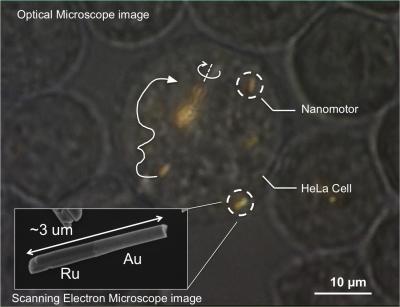For the first time, scientists at Penn State University have placed tiny synthetic motors inside live human cells, propelled them with  ultrasonic waves and steered them magnetically.
ultrasonic waves and steered them magnetically.
It's not exactly "mini RoboCop quite yet," says lead author Professor Tom Mallouk, but he does hope, in the future, such nanobots will be able to cruise around patient's bodies, diagnosing and treating infection and removing cancers.
In nature biological systems have evolved small scale motor systems to help move things around. During cell division, for example, DNA is dragged to opposite sides of the cell using something similar to rope being hauled in. Bacteria use corkscrew shaped tails to propel them through liquid.
Scientists have been trying making inorganic versions of these types of transport systems but have struggled finding the right fuel for these chemical motors. Published this week in Angewandte Chemie International Edition, a new approach has been created: fueling nano motors using ultrasound and magnets.
Lead author Wei Wang made, completely by accident, a rocket shaped chemical motor, instead of the traditionally tested cylindrical motors they use. He was in a hurry in the lab and plated out the motors slapdash, serendipitously producing these new, more streamlined, shaped bots.
He found he could then propel these bots inside cells using ultrasonic waves (using the same ultrasound intensity used when imaging a baby in womb, so not at levels dangerous to humans) and was able to steer the motors using hand held magnets that were only slightly more powerful than the earth's magnetic field.
The scientists hope such technology will, in the future, help get rid of brain tumours, clean up cholesterol in clogged up arteries and help diagnose disease.
They are now trying to link the nanobots to computer chips and sensors so that the bots can communicate within the environment they are in, and to a surgeon sitting at a computer screen.
- Previous Fusion experiment breaks crucial energy
- Next Marius the Giraffe










Comments
Add a comment